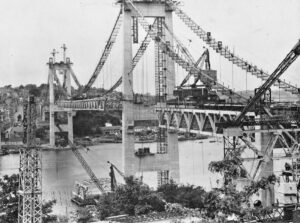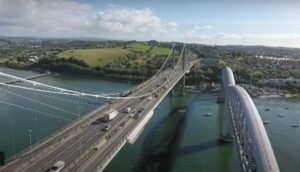Ertach Kernow - Crossing the Tamar to Cornwall
Cornwall opened to railway transport from England in 1859 with the opening of the Royal Albert Bridge. It would be 102 years later on 24th October 1961 that the Tamar road bridge opened to the public for the first time. The formal opening by Queen Elizabeth The Queen Mother would need to wait until April 26th the following year. Tourism had opened up in Cornwall through the railway’s in the 19th century, and with the war years now drifting into the past, far more people were owning motor vehicles and using these to visit Cornwall. There had been an increase in the number of people owning caravans during the 1950’s with Cornwall becoming a popular destination as more camping sites opened. The situation was becoming difficult with only the Torpoint and Saltash ferries able to transport road vehicles across the lower River Tamar. Further upwards there were smaller medieval bridges unable to take large amounts of modern traffic. There continues to be an issue with several of these historic bridges being damaged by poor driving.
The other major access into Cornwall is via the alternative A30. As the early coaching road to Land's End, it was the most important route, described as the "Great Road to Land's End" in Lysons Magna Britannia published in 1814. This route crossed the Tamar at Launceston on the Polson Bridge, which replaced the 13th century medieval bridge in 1835, but was inadequate for 20th century traffic. In 1978 Launceston was bypassed and the A30 was rerouted with the new Dunheved Bridge built over the Tamar. The 19th century Polson Bridge remains, crossing the Tamar on the A388. However, by 2005 the Dunheved Bridge was showing signs of concrete cancer so between 2006 and 2007 this was rebuilt. With the road improvements recently completed at Temple and many towns bypassed the A30 remains the major route into Cornwall as it has been for many centuries.
Further up the Tamar from the A38 the next bridge was Gunnislake New Bridge, the furthest downstream of all the bridges until completion of the Tamar Bridge. Built in 1520 this was the closest to the Saltash-Plymouth crossing as an alternative to travel by car or historically by coach avoiding a ferry crossing. This is a one-way bridge and of course totally unacceptable for modern traffic, even back to the mid-20th century. Ferries had operated at Saltash and Torpoint for centuries, but the increased traffic and size of vehicles needing to cross by 1950 was making this as the only form of crossing untenable.
Construction of a bridge at Saltash was not a new idea and this had already been discussed during the 1930’s. By 1950 it was again being discussed by Cornwall County Council and Plymouth City Council, but there was no enthusiasm from Central government to fund the scheme. Self-funding was the only alternative, and a joint arrangement was put in place by both councils and run by the Tamar Bridge and Torpoint Ferry Joint Committee. This was a major undertaking and the first one of this kind post WWII. The work was carried out by the Cleveland Bridge & Engineering Company founded in 1877. This company had been building bridges since 1892 and would over its existence build bridges throughout the world. Sadly, it was announced on 10th September 2021 this company would be wound up. The bridge would take two years and three months to complete at a original cost of £1.5 million.
Although a century apart in their construction, the Royal Albert Bridge carrying the railway line and the Tamar Bridge linking the road systems between Plymouth and Cornwall have many similarities. With their construction both needed to have towers constructed in the bed of the River Tamar. Both are suspension bridges although the Royal Albert Bridge is of a unique design and may be properly described as a bowstring suspension bridge. In both their constructions caissons needed to be sunk into the river until they reached a rock base some 45 feet below the high-water mark. These caissons made of iron in 19th century and later steel were sunk into the river mud, which was then removed. Air pressure needed to be maintained to keep out water and masonry and stone built within, along with addition of concrete for the later bridge.
Large anchorages needed to be provided for the later Tamar Bridge, the cables going fifty feet into solid rock and then thousands of tons of concrete added. Brunel avoided this with the Royal Albert Bridge through his unique design. Construction of the towers was very different with the later bridge using reinforced concrete, with Brunel using masonry for the landward towers and cast-iron octagonal columns for the central pier. Both bridges used barges or pontoons to transport the sections out to the positions they would need to be raised up from, after being constructed on land. The sections for the later bridge being far smaller than the huge sections for the Royal Albert Bridge.
Due to the increased weights of the vehicles and trains crossing over them both bridges have needed strengthening. The opportunities for the Royal Albert Bridge being limited due to its design. During the age of steam locomotives, the King class amongst the heaviest engines were changed at Plymouth for lighter engines to cross the bridge. Comparison between early photographs and later ones show strengthening by way of 401 cross girders in 1905 and various other cross bracing since then. A ten-million-pound refurbishment took place from 2011 replacing 50,000 bolts, adding 100 tons of steel and repainting. The newer Tamar Bridge although now just sixty years old has undergone a massive amount of work. This is due to the huge increase in traffic and also European Union directives requiring it to support vehicles of up to forty tons. Although designed for just two tons less than this it was found in 1995 to be able to support only seventeen-ton vehicles. The cost of a new crossing estimated at £300 million was out of the question, so alterations and strengthening was the only alternative. The bridge needed to remain open, so the Tamar Bridge became the world’s first suspension bridge being widened using cantilevers. The original deck of the bridge was reinforced concrete six inches thick with asphalt of 1.5 inches. The deck was strengthened by removal of the original concrete decking and replacing with 82 orthotropic panels, each weighing twenty tons. Orthotropic panels are now widely used for new bridge construction and are fabricated units consisting of structural steel deck plates, stiffened in various directs as required. It helps that these designs are interchangeable depending on individual bridge requirements and conditions. The cantilevered widened sections also used orthotropic panels and ultimately these additions and replacements meant the bridge was 25 tons lighter than originally constructed. The project won the British Construction Industry Civil Engineering Award in 2002.
Besides increased numbers of tourist coming to Cornwall via Plymouth, the growth of Plymouth has led to a number of towns in Cornwall becoming commuter communities. The amount of traffic travelling back and forth from these every day has increased traffic substantially. The annual number of vehicles now using the bridge has risen to 16 million and up to 50,000 on a busy weekday. This is an incredible increase from when first constructed with about 4,000 vehicles using the Tamar Bridge each day in 1961.
At the moment the Tamar Bridge is undergoing resurfacing and this work is expected to be completed by the end of October 2021. Many of us have an occasional gripe about paying £2.00 to get out of Cornwall but let’s be happy that we don’t have to queue for a ferry or take a longer route. Happily, the improvements to crossing the Tamar over the past 60 years mean our medieval and historic bridges have less use and those interested will be able to enjoy viewing these on leisurely scenic side trips when leaving Cornwall for many years to come.


![Newbridge Gunnislake [3] Newbridge Gunnislake](https://www.cornwallheritage.com/wp-content/uploads/2021/10/Newbridge-Gunnislake-3-300x193.jpg)







![[69] Voice - Ertach Kernow- 201021A Crossing the Tamar [S] Ertach Kernow - Crossing the Tamar](https://www.cornwallheritage.com/wp-content/uploads/2021/10/69-Voice-Ertach-Kernow-201021A-Crossing-the-Tamar-S-225x300.jpg)
![[69] Voice - Ertach Kernow- 201021B Crossing the Tamar [S] Ertach Kernow - Crossing the Tamar](https://www.cornwallheritage.com/wp-content/uploads/2021/10/69-Voice-Ertach-Kernow-201021B-Crossing-the-Tamar-S-227x300.jpg)
![[69] Ertach Kernow Heritage Column - 20th October 2021 - Cornish Celtic Music Live – Lowender Peran Celtic Festival Ertach Kernow Heritage Column - 20th October 2021 - Cornish Celtic Music Live – Lowender Peran Celtic Festival](https://www.cornwallheritage.com/wp-content/uploads/2021/10/69_ER1-277x300.jpg)